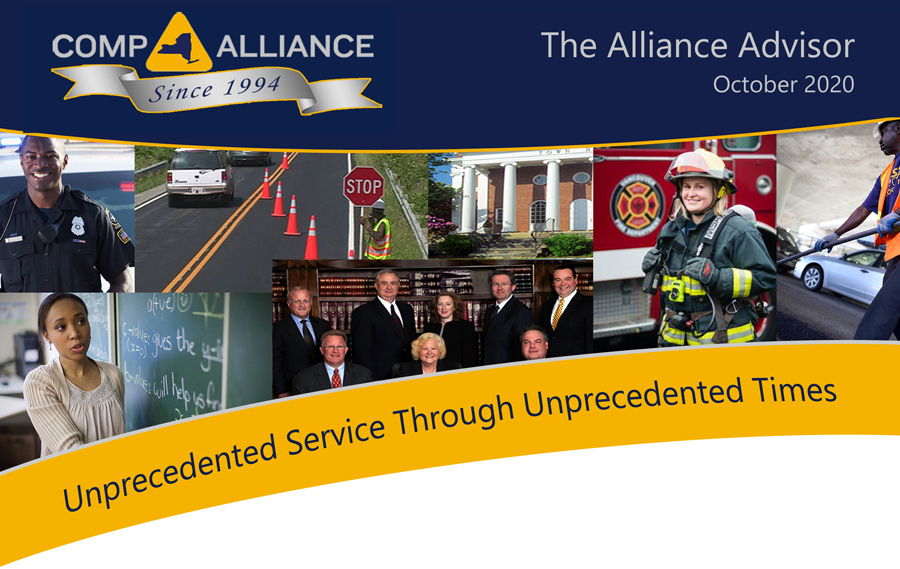
In This Issue
- Comp Alliance Issues Member Loyalty Award for 2020
- NYCOM’s Virtual Fall Training School is a Virtual Hit!
- Live Virtual Safety Seminar Schedule through December 2020
- Fall Back Safely - Daylight Savings Safety
- Key Roles of OSHA and PESH During Pandemic
- NYS Local Governments and Schools to Develop Communicable Disease Continuous Operation Plans
- Safety Culture for the Winter of 2020-2021
- Additional Online Safety Training Resources Added to the Comp Alliance Academy
- When Can I Go Back to Work at School?
- Stay Informed
Comp Alliance Issues Member Loyalty Award for 2020
The New York State Municipal Workers’ Compensation Alliance (Comp Alliance) has issued a Loyalty Award to all members with June and July policy dates. Remaining eligible members on February 1, 2021 can expect their checks shortly thereafter.
The Comp Alliance Board of Trustees recognizes the difficulties its members are going through in this unprecedented time. In appreciation of its members that have stood by the Comp Alliance and contributed to its continued success, the Comp Alliance is using its strong financial position to support our members by returning a portion of its surplus. This special monetary award reflects recognition by the Board of Trustees of fiscal challenges faced by municipalities and provides a tangible benefit of municipal cooperation by returning funds to local governments and schools for the betterment of their communities.
Award amounts are based on the individual member’s longevity of membership with the Comp Alliance and its annual funding contribution.
The Comp Alliance is a not-for-profit workers’ compensation group self-insurance program for municipalities and school districts, with a focus on improving workplace safety and providing stable funding for its members. When the Alliance was formed in the early 1990’s, municipalities in New York struggled to annually budget for unpredictable workers’ compensation costs. The Comp Alliance offers its members budgetary stability and the opportunity to achieve significant savings by sharing the costs of workers’ compensation insurance.
With sponsorship and oversight by the Association of Towns of the State of New York and New York State Conference of Mayors, the Comp Alliance’s mission remains the same as it was more than 25 years ago - ensuring members are able to meet their long-term workers’ compensation liabilities while maintaining stable funding contributions.
For more information on the Member Loyalty Award Program, please contact a Comp Alliance Marketing Manager or your insurance broker. Visit the Comp Alliance at www.compalliance.org for more information, as well as on Twitter and Facebook for additional program enhancements and announcements.
NYCOM’s Virtual Fall Training School is a Virtual Hit!
This year’s NYCOM Fall Training School was a first-class virtual event with the educational sessions and unique networking opportunities that New York State municipalities have come to expect from NYCOM.
While this could never fully compare with the in-person event, NYCOM and all involved made the most of the necessity for a virtual setting during this highly successful conference. The 3 day event included over 30 training sessions, seminars, virtual exhibit hall, and much more.
During the virtual conference, the Comp Alliance was honored to present its annual G. Jeffrey Haber Leadership Award to the City of Corning and Village of Frankfort.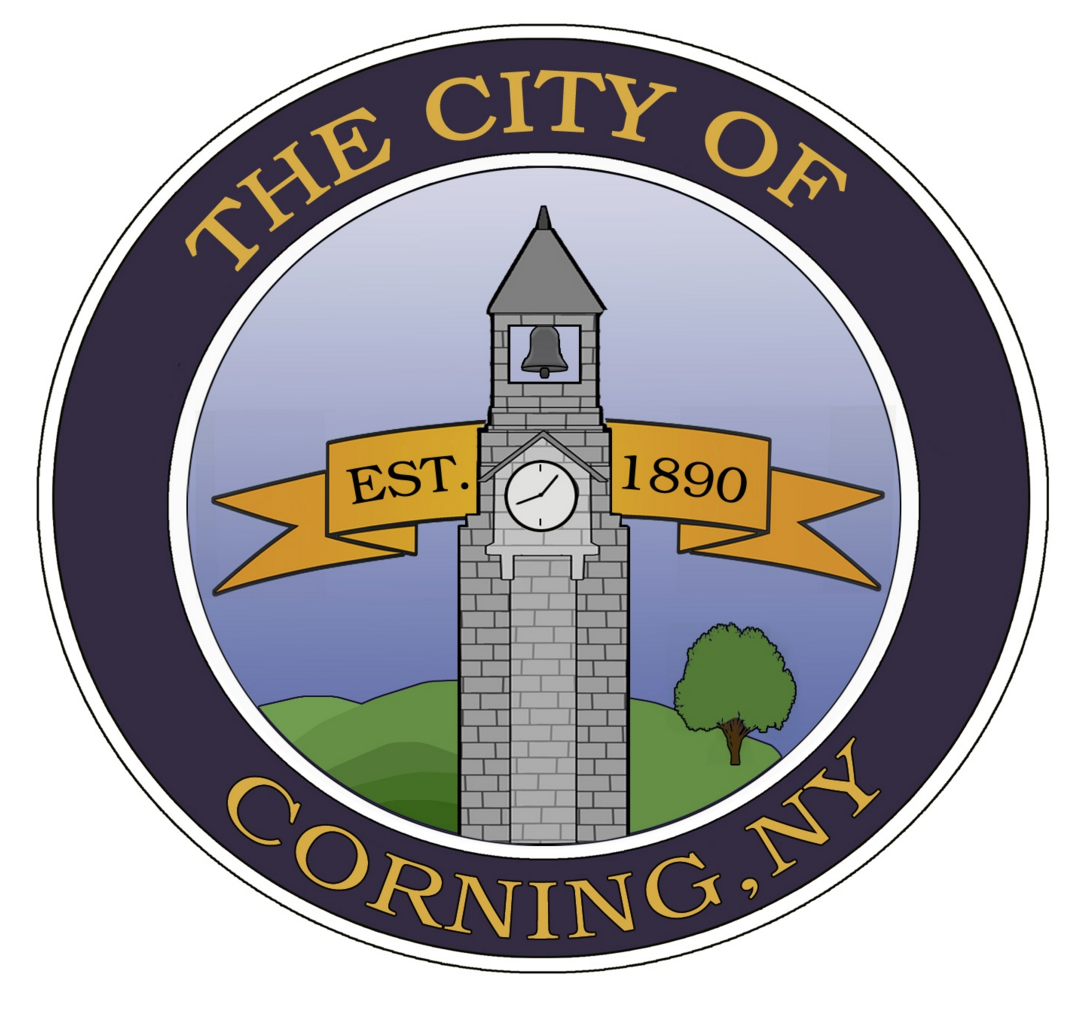
 Corning Mayor, Bill Boland and Frankfort Mayor, Richard Adams (Clerk Karlee Tamburro accepted on his behalf) received the awards from Comp Alliance Executive Director, Michael Kenneally and NYCOM Executive Director, Peter Baynes on Thursday, September 24, 2020 at the New York Conference of Mayors (NYCOM) Fall Training School.
Corning Mayor, Bill Boland and Frankfort Mayor, Richard Adams (Clerk Karlee Tamburro accepted on his behalf) received the awards from Comp Alliance Executive Director, Michael Kenneally and NYCOM Executive Director, Peter Baynes on Thursday, September 24, 2020 at the New York Conference of Mayors (NYCOM) Fall Training School.
These program members received the award in recognition of their efforts to minimize the amount of time lost to workplace injury through claims management practices and return-to-work initiatives. The leadership that the City of Corning and the Village of Frankfort have shown is an example for all program members. Congratulations again to the City of Corning and the Village of Frankfort.
Also during NYCOM’s virtual conference the Comp Alliance presented on the topic of Sexual Harassment. The workshop trained municipal officials on their obligation to identify and prevent sexual harassment in the workplace, including compliance with the elements of the state’s sexual harassment laws and regulations. Using New York State’s model policy as a guide, the Alliance covered the required elements of local policies and the required training protocol, as well as best practices to ensure proper implementation of the policy complaint process.
Robert Blaisdell, Director of Loss Control also presented a virtual training for the Fall Training School on Re-opening Municipal Operations. The program reviewed current CDC and NYS guidelines for municipal compliance during the pandemic, including creating a positive Safety Culture throughout municipal operations. Bob spoke of the exposures presented by COVID-19 and possible corrective measures to consider.
Thank you to all who made this year’s NYCOM Fall Training School such an instant virtual hit.
Comp Alliance Live Virtual Safety Seminar Schedule Announced into December
Since the COVID-19 outbreak has prevented the Comp Alliance Risk Management Team from presenting on site safety trainings and to meet social distancing guidelines the Comp Alliance is utilizing live virtual trainings to help our program members meet their annual PESH compliance guidelines. The Comp Alliance Events Calendar (more information below) includes our up-to-date safety training schedule.
With more than 40 training seminars currently scheduled in October and November, members are sure to find one at a date and time that is convenient. Please visit the Comp Alliance Events Calendar to find one at a convenient date and time for you. The calendar, which is located at www.compalliance.org/events/calendar.html, is your go to location for a listing of all upcoming Comp Alliance safety trainings, conferences, presentations, events and more.
If you have any questions related to the Zoom Live Trainings and registering please contact Robert Blaisdell by emailing This email address is being protected from spambots. You need JavaScript enabled to view it..
Fall Back Safely - Daylight Savings Safety
On November 1, most of those in the United States will turn their clocks back one hour for the end of Daylight Saving Time. Many of us think: “Fantastic! I get another hour of sleep”; and yes, you will. However, there is a huge difference between the “society clock” and the “biological clock” we all work from. During such time changes there is statistically an increase in workplace injury incidents.
Various medical studies from over the years have suggested, that in the days following the ‘spring forward’ and the ‘fall back’ process, people could be more likely to suffer things like heart attacks and car crashes due to sleep disruption. It generally takes about a week for the average person to adjust to the altered time schedule. In that time, many people experience difficulty falling asleep at night, tiredness during the day and feelings of restlessness – all of which are circumstances that lead to workplace injuries.
Some things to keep in mind when switching back to standard time are:
Fatigue: Studies suggest that it takes people who work traditional hours several days to fully readjust their sleep schedule after the time change. While it may seem great to get an extra hour of sleep as opposed to losing an hour in the spring, there is a physiological consequence to changing our clocks. Don’t be surprised if you feel a bit sluggish during the first week or so of November. Those in high-hazard and safety-sensitive positions should take measured controls to minimize injuries and supervisors should monitor their behaviors closely during this time.
Accidents: Evidence suggests that time changes increase safety problems both at work and at home. Just being aware of the increased risk of accidents in the period immediately following the time change may help you stay alert. Try to avoid building up a sleep debt in the days before the change.
Dispose of expired medications. Expiration dates matter when it comes to medications, prescribed and over-the-counter. Serious problems can be caused from taking very common expired over-the-count medication. Dispose of and replace medications in your facility’s first aid kit.
Workplace Violence Risks: Workplace violence is always a serious concern for your staff, however when it gets dark earlier in the evening, it can be an additional workplace violence risk - due to limited visibility at night. It is a good idea to have someone walk you to your vehicle if you feel uncomfortable or unsafe and call/text someone at your home to alert them you are leaving your facility.
Ensure outdoor lighting is working properly. Many outdoor lights such as those illuminating walkways and parking lots are on timers or photocell light sensors. Make sure that appropriate personnel adjust timers to reflect the sunset times.
Change all batteries throughout your facility. Some of these items will include thermostats, outdoor lighting, clocks, phone accessories, flashlights, water conditioners and portable electronics. Check and replace the batteries in your smoke and carbon monoxide (CO) alarms. Ensure they are working properly and replace the batteries. As the cold sets in and many start up their gas-fired furnaces, fireplaces, portable unit heaters and the like for the first time, carbon monoxide poisoning risks increase dramatically during this time of year. Replace any smoke alarm unit that is older than 10 years. Replace any CO alarm unit that is older than 5 years.
Key Roles of OSHA and PESH During Pandemic Conditions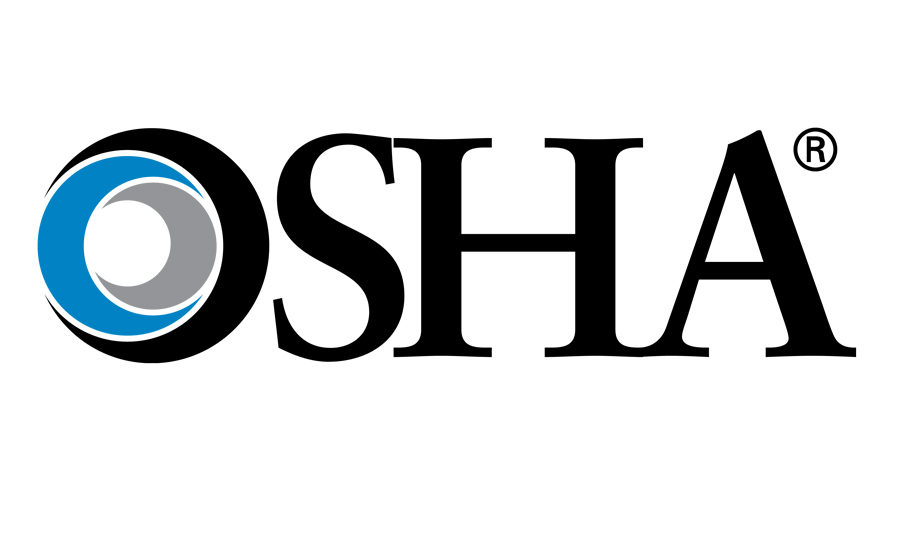
Recently, OSHA sited a number of healthcare facilities for violations related to their coronavirus pandemic response and inability to maintain adequate safety protocols. Although these may have been for facilities outside the usual Comp Alliance member exposures, it is important to understand that a number of these violations were for safety standards which you municipality should continue to uphold and practice.
OSHA and PESH play a key role in making your facilities and workplaces a safe and healthy place to work. During the pandemic our work lives have changed drastically but safety should remain a large concern for all. Recent violations identified by OSHA included lack of proper personal protective equipment (PPE), failure to report workplace injuries and non-compliance with the OSHA General Duty Clause.
First and foremost, as our Risk Management Department continues to emphasize and train on, PPE as it helps us do our jobs safely from the usual risks like getting dust in our eyes or hitting our thumbs with a hammer. PPE should be thought of as much more than that - PPE can prevent dangerous illnesses, burns, amputations and even death. All municipal employers must look to provide appropriate PPE, have it readily available to staff, confirm it is in good condition when in use, and train employees on the proper use of such equipment. Failure to do so, as OSHA recently sited, may be putting employees at risk of severe injury, including from pandemic conditions.
Protective equipment, including personal protective equipment for eyes, face, head, and extremities, protective clothing, respiratory devices, and protective shields and barriers, shall be provided, used, and maintained in a sanitary and reliable condition wherever it is necessary by reason of hazards of processes or environment, chemical hazards, infectious hazards, or mechanical irritants encountered in a manner capable of causing injury or impairment in the function of any part of the body through absorption, inhalation or physical contact.
Additional violations from these recent OSHA facility inspections were for failure to report injuries properly. Workplace injuries occurring in New York State, sustained by Comp Alliance members should be reported through the use of the C-2F form for reporting a workplace injury. In addition, the employer must use SH 900, SH 900.1, and SH 900.2 forms, or equivalent forms, and associated instructions, for recordable injuries and illnesses. Recordable injuries and illness is one that occurred at work, is a new case, and includes at least one of these criteria – involves a death, requires days away from work, requires restricted work or transfer, requires medical treatment beyond first aide, includes loss of consciousness, or is identified as a significant injury or illness diagnosed by a physician or other healthcare professional (OSHA standard 1904.7). The SH 900 form is called the Log of Work-Related Injuries and Illnesses, the SH 900.1 is the Annual Summary of Work-Related Injuries and Illnesses, and the SH 900.2 form is called the Injury and Illness Incident Report. Remember that the Annual Summary for the previous calendar year is required to be posted in a conspicuous area within all work locations for the duration between February 1 through April 30.
The overall goal is that each and every employee in our workforce returns home safely at the end of each workday, without illness or injury. While it’s an employer’s job to ensure the safety and well-being of their employees, workers should always take it upon themselves as well – we all have responsibilities to comply with current OSHA safety standards.
NYS Local Governments and Schools to Develop Communicable Disease Continuous Operation Plans

In September, Governor Cuomo signed into law legislation (S8617B/A10832) that requires all public employers to create plans to adequately protect workers in the event of another state disaster emergency involving a communicable disease. The plans would apply to both the state and localities, including school districts. Plans must be submitted to unions and labor management committees within 150 days of the effective date of the law (roughly on or about February 1, 2021) and plans need to be finalized on April 1, 2021.
The plans are intended to protect all public workers from a future pandemic and avoid the associated public health-crisis conditions throughout the state. The plans will include protections for essential workers and protocols for securing Personal Protective Equipment (PPE).
According to the law, operation plans must include:
- A list and description of positions considered essential;
- A description of protocols to follow to enable all non-essential employees to work remotely;
- A description of how employers would stagger work shifts to reduce overcrowding;
- The protocols for PPE;
- The protocol for when an employee is exposed to disease;
- The protocol for documenting hours and work locations for essential workers;
- The protocol for working with essential employees' localities for identifying emergency housing if needed;
- Any other requirement determined by the New York State Department of Health, such as testing and contact tracing.
The majority of these above points have, most likely, already been discussed and instituted at your municipality or school district, in which case they would have to be re-visited and placed into document-form for your plan. Although NYS has not yet produced a model template for local governments and school districts to utilize, we have identified the following resources to assist you in developing your operation plan:
|
Center for Disease Control (CDC) https://www.cdc.gov/flu/pandemic-resources/planning-preparedness/state-local-government-planning.html Federal Emergency Management Agency (FEMA) https://www.fema.gov/sites/default/files/2020-08/fema_pandemic-influenza-continuity-of-operations.pdf NYS Department of Health (DOH) https://www.governor.ny.gov/sites/governor.ny.gov/files/atoms/files/NYS_BusinessReopeningSafetyPlanTemplate.pdf?fbclid=IwAR0-ccsUuOmhCm9UlQNtdz8ufxdPtQFXzKUpSiSzf9Ie9vv4hZumc-BUlyI |
|
The Comp Alliance will keep its members up-to-date on developments related to continuous operation plans from NYS. Our Risk Management department will provide assistance where we can, in an effort at reducing workplace injuries and exposures during a future communicable disease pandemic crisis. |
Safety Culture for the Winter of 2020-2021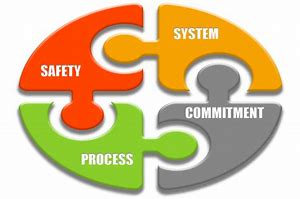
We have made it to the Fall and Winter is just around the corner. It is a good time review, through the lens of our safety-culture program, the practices to get us safely through the coming period of cold, ice and snow. By now, all of our Comp Alliance members should have a strong focus on their “Culture of Safety” the attitudes, beliefs and work practices an organization maintains towards safe work conditions. It equates to the positive application of safety standards within your department. The winter months pose the usual workplace safety concerns but it’s always pertinent to review your department operations and the safety protocols in place.
The OSHA General Duty Clause relies on each employer to furnish to each of its employees employment and a place of employment which are free from recognized hazards that are causing or are likely to cause death or serious physical harm to employees. Although there are no Federal or New York State laws that specifically mandate training for your staff on winter safety, the exposures and hazards that municipal workers face during the colder months are covered by the General Duty Clause. For any employee who is required to work outdoors during the winter months, exposure to cold, foul weather and slippery conditions would be considered a “recognized hazard”. It is the employer’s duty to provide training and properly equip the staff to recognize and be protected from these winter hazards.
Slip/Fall Hazards - Your staff should be required to wear proper footwear at all times. In colder months, your staff should be reminded to check the treads of their work boots/shoes to help to prevent slips and falls on wet or icy surfaces. For work on extremely slippery surfaces, the use of cleats or slip-on grips may be needed – these are especially helpful for police officers. Your staff should also be reminded to take it slow and maintain a stable center-of-gravity when walking across slippery yards or parking lots. Office staff should be instructed to wear boots to and from their cars and change to office footwear once they arrive indoors. Slick conditions (ice, snow, leaves) should also be noted and corrected as soon as possible, and watch for areas that accumulate water and ice quickly.
Shoveling Snow – the physical demand of removing snow by hand can cause serious injury. Working out in the cold for extended periods, coupled with strenuous activities and over-exertion, especially if a person does not exercise regularly, can result in a heart attack or other serious injuries. Warm-up exercises before shoveling snow are recommended, as are frequent rest breaks to warm up and prevent dehydration. Stop shoveling if you experience shortness of breath, chest pain or any other signs of a heart attack. When manually removing snow, choose a shovel that has a comfortable grip and is the correct height and length of the user. Spacing your hands on the grip to increase leverage and pushing the snow, instead of lifting it will help to prevent back injuries.
Cold Stress - Anyone who is required to work outdoors, or in unheated or poorly heated garage bays and utility buildings, during the winter months is at risk of cold stress related injuries. Sanitation workers, highway department employees, police and fire personnel, snow clean-up and removal crews, as well as emergency medical technicians should be reminded to take proper precautions over the coming months. Proper dress and keeping dry and hydrated are the key to avoiding cold stress. Dress in layers and avoid overly tight clothing. Also wear winter hats and gloves but take care not have loose clothing (e.g. scarves) near motorized equipment.
Cold winter weather and wind chills force the body to work harder to maintain the core temperature (wind chill is the temperature that the body feels when air temperature and wind speed are combined). Prolonged work in cold environments may drive down skin temperature and cause serious health problems, tissue damage and even death.
When faced with prolonged exposure to cold, the body strives to maintain core internal temperature, shifting blood flow away from the outer skin and extremities (hands, feet, arms and legs), to the chest and abdomen. This shift causes the skin and extremities to cool and may result in frostbite, hypothermia and a condition known as trench foot.
Workers who have to work outdoors for extended periods should be provided with warming stations or be allowed to take frequent breaks indoors. Warm, sweetened, non-alcoholic liquids, should be provided, as it is easier to become dehydrated in colder weather. Working in teams is recommended so that the staff can monitor each other for signs of cold stress.
Winter Driving – A majority of deaths and serious injuries during snow and ice conditions occur from vehicle accidents! Safe driving practices should be stressed with your employees throughout the entire year. However, during the winter season, when faced with hazardous road conditions that are not under your control, your municipal drivers should be reminded of your safe driving policies regularly. Commercial Motor Vehicles require a pre-trip inspection prior to operation, and special attention to plow trucks is necessary. Drivers should be wearing proper reflective clothing in the event they have to leave their vehicle while on-route. A good vehicle maintenance program should be in place to ensure that all fluids are at proper levels, brakes and tires are in good condition and cooling, electrical and exhaust systems are functioning properly. Emergency notification equipment should also be available and maintained in the event of a vehicle breakdown.
Remember to take a look at your commencing winter operations and review the safety protocols for each. Confirm that employee attitudes and values benefit your safety culture through commitment to realistic safety practices for continuous organizational learning, improving hazard awareness and management for hazards shared across the workforce.
Additional Safety Training Resources Added to the Comp Alliance Academy 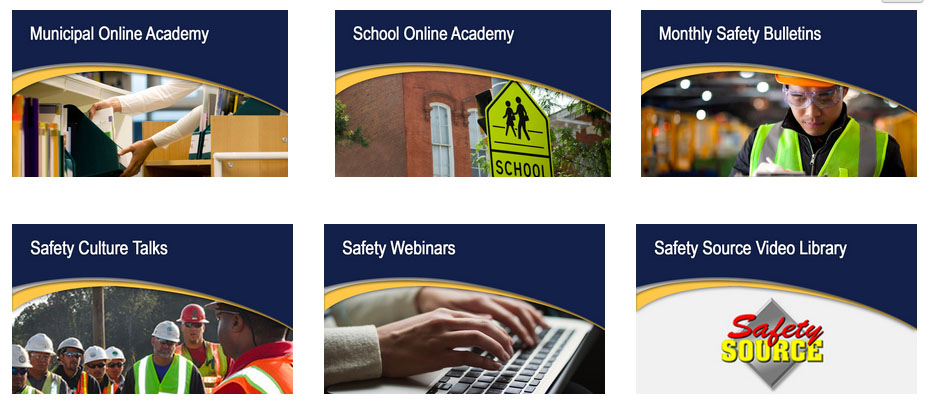
New Safety Training Videos Covering Several PESH Required Topics Available Through the Comp Alliance Academy
The Comp Alliance is focused on delivering the best service to all program members. During the past 7 months the COVID-19 pandemic has led to an increasing demand for virtual safety training. We have provided several webinars, and the required PESH training topics to hundreds of program members and their employees during this time. In addition to providing several seminars per week the Comp Alliance has also added updated safety seminars to the Comp Alliance Academy.
Employees can login at a convenient time, while adhering to social distance guidelines and complete the PESH required safety trainings. To access the new virtual PESH training courses and many other safety training topics please visit www.compalliance.org and click on the Comp Alliance Academy. Both the Comp Alliance Municipal and School Academy include the new PESH virtual training videos. If you are not a registered user please send your request to This email address is being protected from spambots. You need JavaScript enabled to view it..
School Members of the Comp Alliance are facing unique challenges of their own during the pandemic. The Comp Alliance recently launched a new Course on the Comp Alliance School Academy (Course 1) which includes several toolbox talks on safely returning to school.
When Can I Go Back To Work At School?
Schools are an important part of the infrastructure of communities and play a critical role in supporting the whole child, not just their academic achievement. Recently, the NYS Department of Health developed an in-person decision making flow-chart for school districts to utilize in determining if and when school staff can return to work at school.
This guidance is intended to aid school administrators as they consider how to protect the health, safety, and well-being of students, teachers, other school staff, their families and communities.
All K-12 school workplaces developing plans to continue operations while COVID-19 outbreaks occur among teachers, staff and students, or in the surrounding community, should:
- Work directly with appropriate state, tribal, local and territorial public health officials, and occupational safety and health professionals.
- Incorporate relevant aspects of CDC guidance, including, but not limited to, CDC’s Schools and Childcare Programs: “Plan, Prepare and Respond” and “Interim Guidance for Businesses and Employers”.
- Incorporate guidance from the Occupational Safety and Health Administration (OSHA) external icon and other federal and state regulatory agencies, as needed.
- Communicate regularly with families, staff and other partners about important COVID-19 information.
Distinctive factors that affect risk for exposure to COVID-19 for teachers and staff in school settings include:
Distance between staff and others: In addition to their primary job functions and interaction with students, school staff may also be near (within 6 feet) one another at times, such as when arriving at school and during breaks. Shared spaces (e.g., break rooms, entrances/exits, restrooms) and shared transportation to and from the school (e.g., personal or public transportation, carpooling, ride sharing) may increase their risk. These can be mitigated or minimized with good practices.
Duration of contact: Extended contact (15 minutes or greater over a 24-hour period) with potentially infectious individuals increases the risk of COVID-19 spread.
Type of contact: Current evidence indicates that COVID-19 spreads primarily through respiratory droplets and short-range aerosols produced when an infected person coughs, sneezes, or talks in close proximity to other people. At this time, long-range airborne transmission does not appear to be a primary way COVID-19 spreads. There is not yet clear evidence that ventilation systems spread the virus from space to space causing exposures. Studies indicate that people who are not showing symptoms (i.e., asymptomatic) can still spread the virus. COVID-19 exposure may also occur from touching one’s mouth, nose, or possibly eyes after contact with contaminated surfaces or objects, such as office equipment, workstations, or break room tables.
Watch for symptoms
People with COVID-19 have had a wide range of symptoms reported – ranging from mild symptoms to severe illness. Symptoms may appear 2-14 days after exposure to the virus. People with these symptoms may have COVID-19:
- Fever or chills
- Cough
- Shortness of breath or difficulty breathing
- Fatigue
- Muscle or body aches
- Headache
- New loss of taste or smell
- Sore throat
- Congestion or runny nose
- Nausea or vomiting
- Diarrhea
This list does not include all possible symptoms. CDC will continue to update this list as we learn more about COVID-19
Screening K-12 school staff for COVID-19
Given the wide range of symptoms and the fact that some people with COVID-19 are pre-symptomatic or asymptomatic, there are limitations to symptom screening for the identification of COVID-19. CDC does not currently recommend that schools conduct universal in-person symptom screenings. One option is to encourage staff to self-screen prior to coming onsite.
Testing of K-12 school staff
CDC does not recommend universal testing of all students and staff. CDC’s Interim Considerations for K-12 School Administrators for SARS-CoV-2 Testing advises that schools should determine, in collaboration with local health officials, whether to implement any testing strategy and, if so, how to best do so.
The enclosed Pre-K to Grade 12 COVID-12 Toolkit is a great guide for reducing the spread of COVID-19 in schools. https://coronavirus.health.ny.gov/system/files/documents/2020/10/prek-gr12_toolkit.pdf
Stay Informed
The Comp Alliance strives to keep members informed of the latest industry and program news. Please visit us at www.compalliance.org for the latest news, updated events calendar, safety articles, safety bulletins and more.
The Alliance also encourages members to visit us on Twitter @nycompalliance and Facebook.

